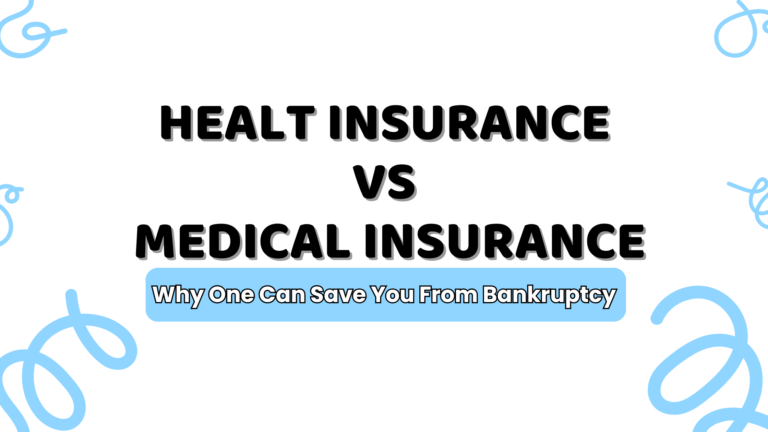
Introduction: The Real Cost of Getting Sick
A medical emergency doesn’t ask for your permission. It arrives suddenly — through a late-night call, a doctor’s diagnosis, or an accident that changes everything. In that moment, two things race through your mind:
- Will my loved one survive?
- How much will this cost us?
In a country like India, where out-of-pocket healthcare expenses are among the highest in the world, families often face a hard choice: Pay from savings, borrow money, or skip treatment altogether.
This is where health insurance and medical loans come into the picture. But they are not the same thing — and choosing the wrong one could lead to years of debt.
Let’s break down the differences and find out which one truly protects your finances when life takes an unexpected turn.
Section 1: What Is Health Insurance?
Health insurance is a financial safety net that pays for your medical expenses in exchange for a small annual premium. It covers:
- Hospital bills
- Surgery costs
- Diagnostic tests
- Day-care treatments
- Pre- and post-hospitalization expenses
If you have health insurance and get hospitalized, the insurer pays the hospital bills (either directly through cashless claims or by reimbursing you later).
Section 2: What Is a Medical Loan?
A medical loan is a personal loan taken specifically to pay for healthcare costs. It is:
- Unsecured (you don’t need to pledge anything)
- Comes with high interest rates (10% to 24% annually)
- Requires EMIs over 1 to 5 years
It’s fast and useful in emergencies, but it doesn’t prevent the cost — it just postpones it with added interest.
Section 3: Quick Comparison Table
| Feature | Health Insurance | Medical Loan |
|---|---|---|
| Payment | Annual premium | Monthly EMIs |
| Cost | Low (₹5,000–₹25,000/year) | High (₹50,000+ interest on ₹2L loan) |
| Emergency Access | Cashless hospitalization | Depends on loan approval time |
| Financial Burden | Minimal | Long-term debt risk |
| Tax Benefit | Yes (under Section 80D) | No |
| Peace of Mind | High | Low |
Section 4: Why Health Insurance Wins (Every Time)
1. It’s Cheaper in the Long Run
Imagine this:
- A ₹5 lakh surgery covered by health insurance costs you just ₹10,000–₹20,000 annually.
- The same surgery with a medical loan? You borrow ₹5 lakhs and repay around ₹6–₹7 lakhs over 3–5 years.
That’s a difference of lakhs.
2. You Don’t Have to Worry During an Emergency
During a health emergency, the last thing you want to do is compare interest rates, fill loan forms, or wait for approval. Health insurance offers instant cashless admission in network hospitals.
3. Prevents Financial Drain
Without insurance, families often:
- Break FDs
- Sell gold
- Swipe credit cards
- Take high-interest loans
Health insurance keeps your savings untouched and your stress lower.
Section 5: But What If You Don’t Have Insurance Yet?
Here’s where medical loans have a small advantage — they can save lives when you’re unprepared. Some situations where loans help:
- You don’t have insurance but need surgery now.
- Your insurance cover is too small (like ₹1 lakh) and hospital bills exceed that.
- Treatment is not covered (like some experimental surgeries or cosmetic procedures).
Medical loans are better than delaying treatment, but they should be your last resort, not your first choice.
Section 6: Why So Many People Still Avoid Health Insurance
Despite the clear benefits, millions of people in India and across the world still don’t buy health insurance. Why?
1. “I’m healthy, I don’t need it.”
That’s when it’s cheapest. Once you develop health conditions, it becomes expensive or gets denied altogether.
2. “I don’t understand the policy.”
This is valid. Insurance terms can be confusing. But today, insurers offer simple plans, and agents or platforms explain everything in detail.
3. “It’s a waste of money if I don’t fall sick.”
This is like saying a seatbelt is a waste if you don’t crash. Insurance is not for regular use — it’s for the big, unexpected things.
Section 7: True Story – Two Families, Two Outcomes
Meet Neha and Karan — both 35, both working professionals.
Neha had no health insurance.
When her father had a heart attack, they spent ₹7 lakhs from savings and took a ₹3 lakh personal loan. She’s still paying EMIs 3 years later.
Karan had a ₹10L family floater policy.
His mother’s cancer treatment cost ₹6.5 lakhs — covered entirely by his policy. No loans, no EMI, no stress.
Same crisis, completely different outcomes.
Section 8: What Kind of Health Insurance Should You Get?
If you don’t have a policy yet, here’s how to start:
1. Start with a Base Plan (₹5L to ₹10L)
- Covers most major treatments
- Annual premium: ₹5,000–₹12,000 for individuals under 35
2. Add a Super Top-Up Plan
- Extends your cover without adding huge cost
- Useful when you already have a small cover via employer
3. Look for These Features
- Cashless network hospitals
- Pre/post hospitalization cover
- Day-care treatment
- Lifetime renewability
Section 9: What If You Already Have Insurance from Work?
That’s a good start, but not enough. Here’s why:
- Most employer policies cover just ₹1–₹3 lakhs
- You lose coverage if you quit or switch jobs
- Claims in employer policy can impact team policy limits
Always have a personal backup policy outside of your job.
Conclusion: Don’t Gamble With Health — or Money
You can’t control when a medical crisis strikes. But you can choose how prepared you are.
Medical loans may help you pay, but health insurance protects you.
Think of health insurance as a safety helmet — you don’t wear it because you expect an accident, but because you want to survive one.
Buy early. Buy smart. Stay protected.